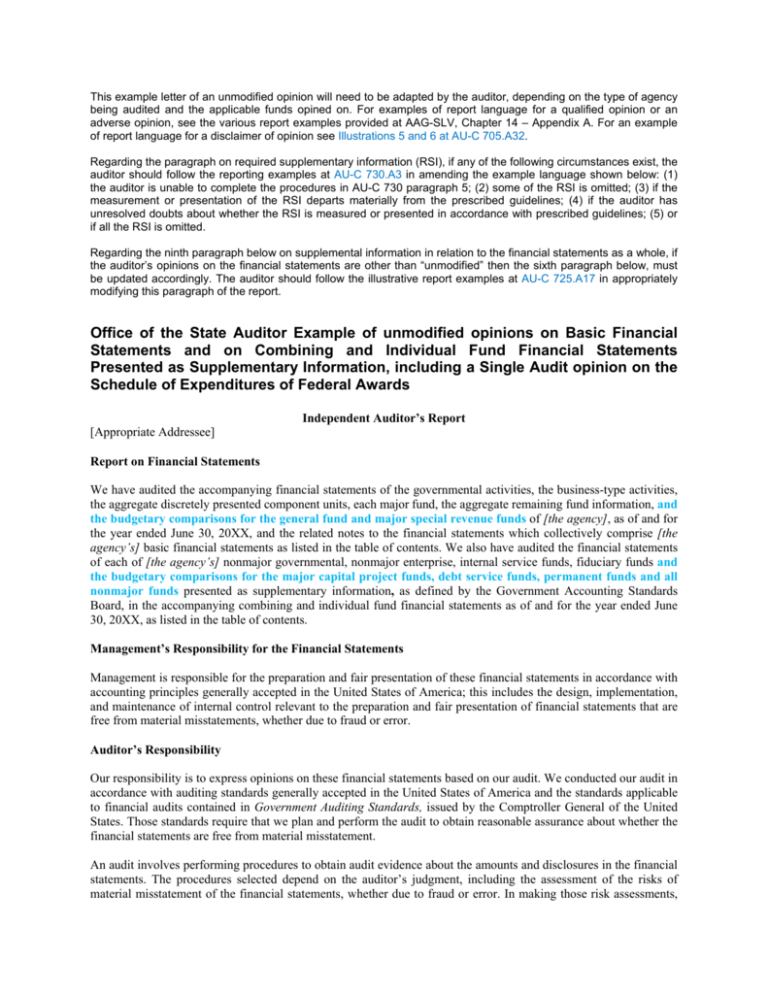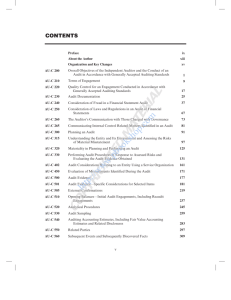Office of the State Auditor Example of unmodified opinions on Basic
advertisement

This example letter of an unmodified opinion will need to be adapted by the auditor, depending on the type of agency being audited and the applicable funds opined on. For examples of report language for a qualified opinion or an adverse opinion, see the various report examples provided at AAG-SLV, Chapter 14 – Appendix A. For an example of report language for a disclaimer of opinion see Illustrations 5 and 6 at AU-C 705.A32. Regarding the paragraph on required supplementary information (RSI), if any of the following circumstances exist, the auditor should follow the reporting examples at AU-C 730.A3 in amending the example language shown below: (1) the auditor is unable to complete the procedures in AU-C 730 paragraph 5; (2) some of the RSI is omitted; (3) if the measurement or presentation of the RSI departs materially from the prescribed guidelines; (4) if the auditor has unresolved doubts about whether the RSI is measured or presented in accordance with prescribed guidelines; (5) or if all the RSI is omitted. Regarding the ninth paragraph below on supplemental information in relation to the financial statements as a whole, if the auditor’s opinions on the financial statements are other than “unmodified” then the sixth paragraph below, must be updated accordingly. The auditor should follow the illustrative report examples at AU-C 725.A17 in appropriately modifying this paragraph of the report. Office of the State Auditor Example of unmodified opinions on Basic Financial Statements and on Combining and Individual Fund Financial Statements Presented as Supplementary Information, including a Single Audit opinion on the Schedule of Expenditures of Federal Awards Independent Auditor’s Report [Appropriate Addressee] Report on Financial Statements We have audited the accompanying financial statements of the governmental activities, the business-type activities, the aggregate discretely presented component units, each major fund, the aggregate remaining fund information, and the budgetary comparisons for the general fund and major special revenue funds of [the agency], as of and for the year ended June 30, 20XX, and the related notes to the financial statements which collectively comprise [the agency’s] basic financial statements as listed in the table of contents. We also have audited the financial statements of each of [the agency’s] nonmajor governmental, nonmajor enterprise, internal service funds, fiduciary funds and the budgetary comparisons for the major capital project funds, debt service funds, permanent funds and all nonmajor funds presented as supplementary information, as defined by the Government Accounting Standards Board, in the accompanying combining and individual fund financial statements as of and for the year ended June 30, 20XX, as listed in the table of contents. Management’s Responsibility for the Financial Statements Management is responsible for the preparation and fair presentation of these financial statements in accordance with accounting principles generally accepted in the United States of America; this includes the design, implementation, and maintenance of internal control relevant to the preparation and fair presentation of financial statements that are free from material misstatements, whether due to fraud or error. Auditor’s Responsibility Our responsibility is to express opinions on these financial statements based on our audit. We conducted our audit in accordance with auditing standards generally accepted in the United States of America and the standards applicable to financial audits contained in Government Auditing Standards, issued by the Comptroller General of the United States. Those standards require that we plan and perform the audit to obtain reasonable assurance about whether the financial statements are free from material misstatement. An audit involves performing procedures to obtain audit evidence about the amounts and disclosures in the financial statements. The procedures selected depend on the auditor’s judgment, including the assessment of the risks of material misstatement of the financial statements, whether due to fraud or error. In making those risk assessments, the auditor considers internal control relevant to the entity’s preparation and fair presentation of the financial statements in order to design audit procedures that are appropriate in the circumstances, but not for the purpose of expressing an opinion on the effectiveness of the entity’s internal control. Accordingly, we express no such opinion. An audit also includes evaluating the appropriateness of accounting policies used and the reasonableness of significant accounting estimates made by management, as well as evaluating the overall presentation of the financial statements. We believe that the audit evidence we have obtained is sufficient and appropriate to provide a basis for our audit opinions. Opinions In our opinion, the financial statements referred to above present fairly, in all material respects, the respective financial position of the governmental activities, the business-type activities, the aggregate discretely presented component units, each major fund, and the aggregate remaining fund information of [the agency], as of June 30, 20XX, and the respective changes in financial position and where applicable, cash flows thereof and the respective budgetary comparisons for the general fund and major special revenue funds for the year then ended in accordance with accounting principles generally accepted in the United States of America. In addition, in our opinion, the financial statements referred to above present fairly, in all material respects, the respective financial position of each nonmajor governmental, nonmajor enterprise, internal service fund and fiduciary fund of [the agency] as of June 30, 20XX, and the respective changes in financial position and cash flows, where applicable, thereof and the respective budgetary comparisons for the major capital project funds, debt service funds, permanent funds and all nonmajor funds for the year then ended in accordance with accounting principles generally accepted in the United States of America. Other Matters Required Supplementary Information (The following wording applies if the auditor applied specified procedures and no material departures from prescribed guidelines were identified) Accounting principles generally accepted in the United States of America require that the management’s discussion and analysis [and list additional RSI included if applicable] on pages XX-XX and XX-XX be presented to supplement the basic financial statements. Such information, although not a part of the basic financial statements, is required by the Governmental Accounting Standards Board who considers it to be an essential part of financial reporting for placing the basic financial statements in an appropriate operational, economic, or historical context. We have applied certain limited procedures to the required supplementary information in accordance with auditing standards generally accepted in the United States of America, which consisted of inquiries of management about the methods of preparing the information and comparing the information for consistency with management’s responses to our inquiries, the basic financial statements, and other knowledge we obtained during our audit of the basic financial statements. We do not express an opinion or provide any assurance on the information because the limited procedures do not provide us with sufficient evidence to express an opinion or provide any assurance. Other Information (This wording applies for an “in-relation-to” opinion on SI and disclaiming an opinion on OI) Our audit was conducted for the purpose of forming opinions on [the agency’s] financial statements, the combining and individual fund financial statements, and the budgetary comparisons. The [Schedule of Expenditures of federal awards as required by Office of Management and Budget Circular A-133, Audits of States, Local Governments, and Non-Profit Organizations, introductory and statistical sections (if applicable), and the other schedules required by Section 2.2.2.NMAC] are presented for purposes of additional analysis and are not a required part of the basic financial statements. The [Schedule of Expenditures of federal awards and other schedules required by Section 2.2.2 NMAC] are the responsibility of management and were derived from and relate directly to the underlying accounting and other records used to prepare the basic financial statements. Such information has been subjected to the auditing procedures applied in the audit of the basic financial statements and certain additional procedures, including comparing and reconciling such information directly to the underlying accounting and other records used to prepare the basic financial statements or to the basic financial statements themselves, and other additional procedures in accordance with the auditing standards generally accepted in the United States of America. In our opinion, the [Schedule of Expenditures and other schedules required by Section 2.2.2 NMAC] are fairly stated, in all material respects, in relation to the basic financial statements as a whole. The [identify accompanying other information] has not been subjected to the auditing procedures applied in the audit of the basic financial statements, and accordingly, we do not express an opinion or provide any assurance on it. Other Reporting Required by Government Auditing Standards In accordance with Government Auditing Standards, we have also issued our report dated [date of report] on our consideration of [the agency’s] internal control over financial reporting and on our tests of its compliance with certain provisions of laws, regulations, contracts, and grant agreements and other matters. The purpose of that report is to describe the scope of our testing of internal control over financial reporting and compliance and the results of that testing, and not to provide an opinion on the internal control over financial reporting or on compliance. That report is an integral part of an audit performed in accordance with Government Auditing Standards in considering [the agency’s] internal control over financial reporting and compliance. [Auditor’s signature] [Auditor’s city and state] [Date of the auditor’s report]






